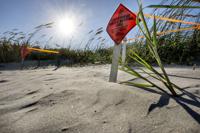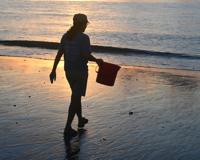South Carolina loggerhead sea turtle nesting was off to a slightly above-average start at the end of July, though the nest count so far trails a record year in 2019.
But this season has been markedly different for the corps of volunteers that help to patrol beaches and protect below-sand caverns of eggs. Social distancing rules have severely limited volunteers' interactions with the public.
Linda Mataya, who leads a group of volunteers in North Myrtle Beach, said some beachgoers became hostile when she told them to back up from a recent hatch.
"A lot of people gave me a hard time about it. They said I had no authority to do that. They said they had the right to be over the turtles taking pictures," Mataya said. "I thought there was going to be fistfights."
As Hurricane Isaias approaches the coast, there's also the risk that nests will be overwashed by storm surge, suffocating future hatchlings before they can emerge. Hurricane Dorian and strong autumnal king tides in 2019 served to eat away at that year's hatch success.
The turtle species that nest along the coast — dominated by the 300-pound loggerhead sea turtle — largely finish nesting by the beginning of August. At least 4,384 nests, or 83 percent of all those laid so far, have yet to finish their two-month incubation period, while the Atlantic churns out tropical cyclones like Isaias on an earlier-than-normal schedule.
Michelle Pate, coordinator of the S.C. Marine Turtle Conservation Program, was working on several last-minute preparations on Friday morning as she spoke with The Post and Courier.
State staff had to remove ATVs and other equipment quickly from undeveloped barrier islands around Charleston before Isaias approached.

Sea Turtle nests are marked in the dunes on Isle of Palms on Monday, July 27, 2020. Grace Beahm Alford/Staff
Changes for volunteers
Social distancing rules from the S.C. Department of Natural Resources, which certifies local sea turtle monitoring groups and oversees the conservation program, have made this season less of a public event.
Every morning during the nesting season, volunteers across the state walk the beach in their respective towns and look for signs that a turtle has come ashore overnight — usually a broad ripple of flipper indentations in the sand. They mark the nests' locations so that beachgoers don't trample them, and in some cases may dig up a nest and remove the eggs to a safer location.
After a nest hatches, volunteers complete an "inventory," or record how many hatchlings emerged and how many eggs failed to hatch at all.
Volunteers used to invite beachwalkers to watch the process, but no more.
"We have to get out there just at first light and do this very quickly, so that we don't have crowds like we used to," said Mary Pringle, who leads the Island Turtle Team of volunteers on Sullivan's Island and the Isle of Palms.

Volunteers Mary Pringle and Christel Cothran work at a green sea turtle nest on Isle of Palms in June 2020. Barbara J. Bergwerf/Provided
It's affected volunteers, too. Pringle said participants on the islands often don't get the chance to watch nest inventories for the egg clutches they found earlier in the season because teams of workers are limited to just two people.
Social media has made these events, particularly nest hatches, something beach visitors have come to expect, Pate said. While that's a positive thing for conservation awareness, it's led to some entitlement.
"People seem to put it on their bucket list — 'Oh, I've got to see it' — and there's an expectation from them," Pate said. "There is some real conservation work that’s trying to get done, and during this pandemic we do need you take a step back."
An average year
Last year, more than half a million hatchlings emerged from more than 8,500 nests on the state's beaches. So far in 2020, almost 5,300 nests have been laid.
It's not necessarily worrying that 2020 has reverted closer to the annual average, Pate said. Mother turtles only nest every two to three years, so conservationists expect some up-and-down.

Volunteer Tee Johannes walks sea turtle hatchlings to the edge of the water at sunrise on July 27, 2020. Barbara J. Bergwerf/Provided
On Cape Romain National Wildlife Refuge, a habitat that regularly hosts a large chunk of the annual nests, the lays so far are approaching 2,300, Refuge Manager Sarah Dawsey said. That would still be the reserve's third-best season on record.
Dawsey was also closely watching Isaias, however, and whether it might cut into the hatch success.
Tropical cyclones don't just run the risk of suffocating nests with water, they can also push additional sand on top of the egg caverns. After Hurricane Dorian last year, volunteers had to dig down through 5 feet of additional sand to complete nest inventories.
With a smaller group of people working this year under distancing rules, that could provide a challenge.
"That's a lot of work to an already overworked volunteer group," Dawsey said.
The Link LonkAugust 01, 2020 at 06:52AM
https://ift.tt/3fmMscp
SC sea turtles log average nesting year as social distancing complicates conservation efforts - Charleston Post Courier
https://ift.tt/2CoSmg4
Sea


/cloudfront-us-east-2.images.arcpublishing.com/reuters/CZF6NULMVVMEXHOP7JK5BSPQUM.jpg)
No comments:
Post a Comment